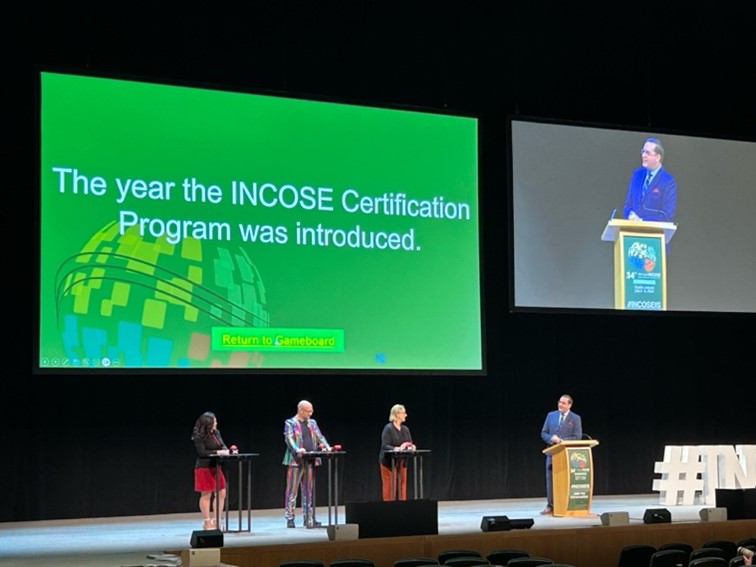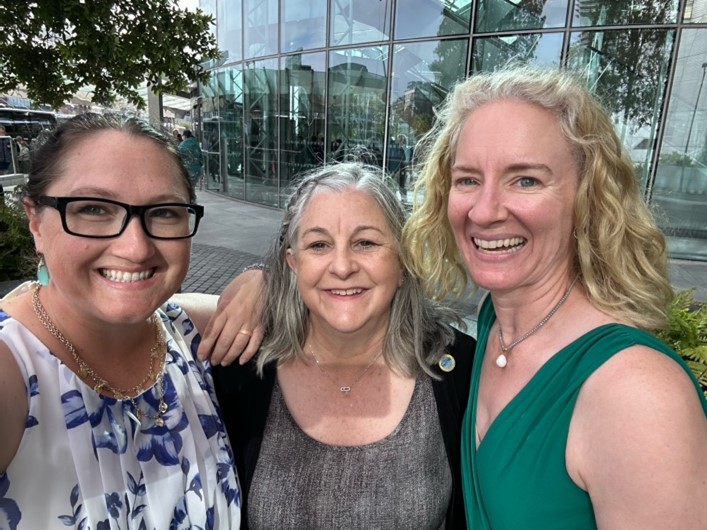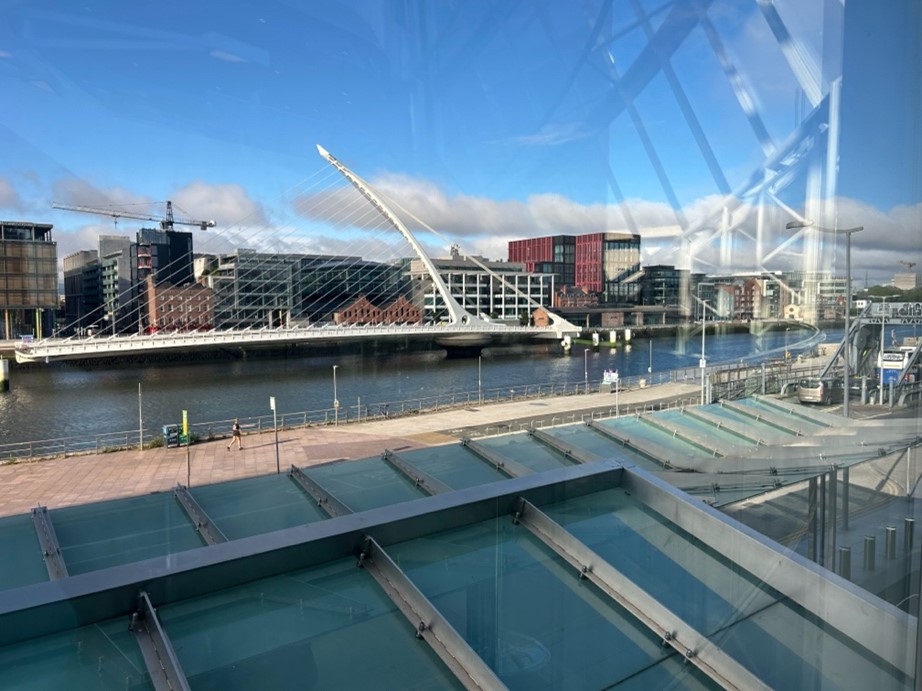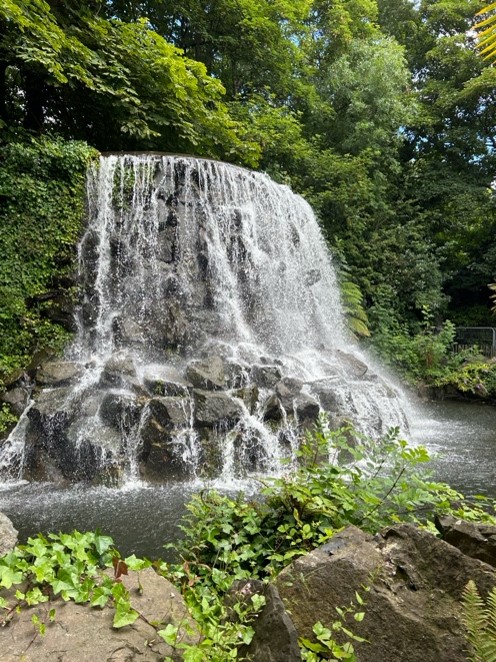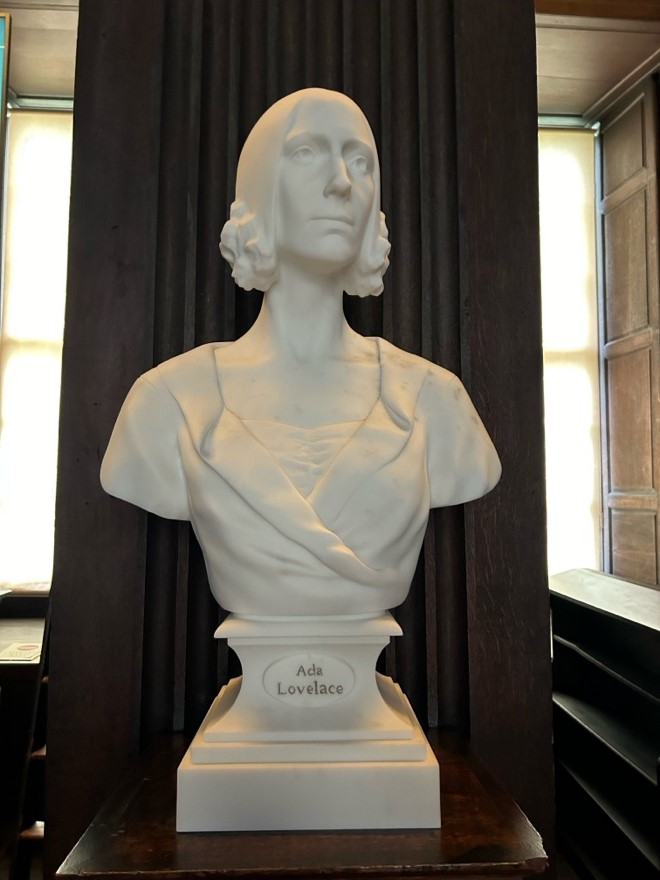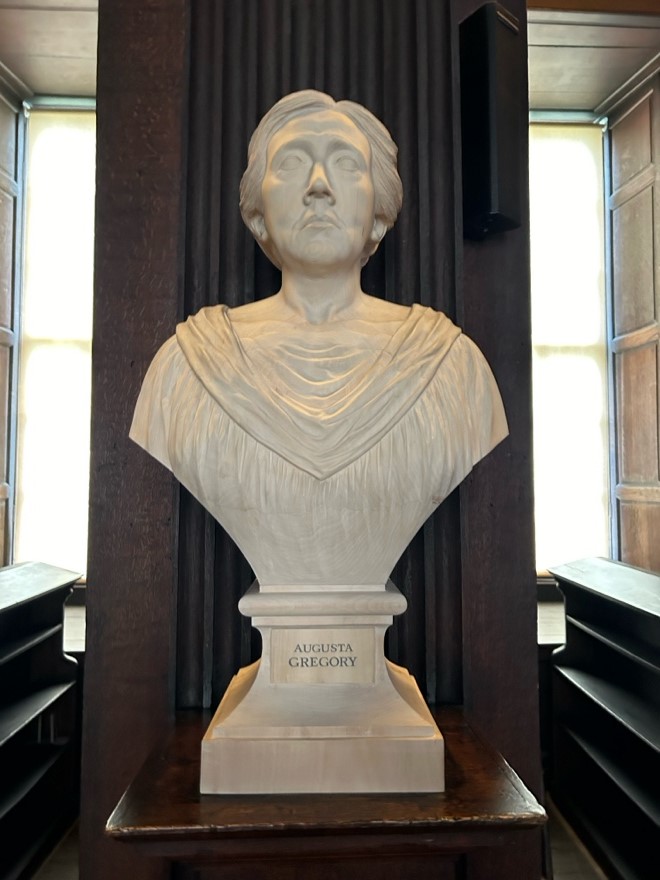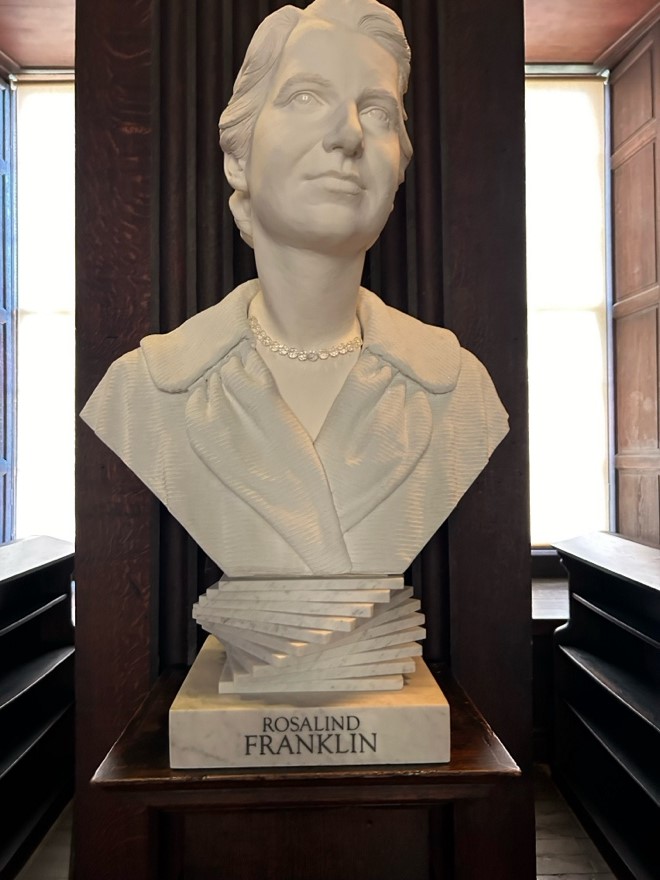Following a family vacation overseas, SERC researcher Dr. Nicole Hutchison compiled this journal of her trip to Ireland for the INCOSE International Symposium in July. Read on for her insights on the workshop and the scene in Dublin.
Monday, July 1 – Preparing for the Show
After dropping my family off at Dublin Airport – an adventure and debacle in itself – I headed to the Convention Center Dublin (CCD) to prepare for the INCOSE International Symposium (IS). CCD is right on the Lyffe River. The atrium has walls of glass that allow the sun, or more frequently during my stay, the cloudy skies, to fill the atrium with light.
It was strange to be in the IS venue on Monday and not be in session. Historically, the IS program starts with tutorials and meetings on the weekend and formally kicks off on Monday, but thanks to a Taylor Swift concert scheduled after the IS was announced, it was shifted to start on Tuesday.
After attending the plenary rehearsals as the deputy MC, I had the pleasure of meeting with SERC researchers Tom McDermott and Megan Clifford to set up our booth. It was great to have a presence and a clear place to showcase SERC news and information.
The afternoon was dedicated to the governing board of the Systems Engineering Body of Knowledge (SEBoK), a group made up of representatives from INCOSE, the IEEE Systems Council, and the SERC/Stevens. It was a treat to see the people I work with in person rather than on my laptop screen, and we were able to make progress on the strategic direction of the SEBoK. The Managing Editor and I, Chris Hoffman (Cummins), then reviewed the agenda for the week’s upcoming SEBoK events.
The IS team held an event for first-time attendees (FTA) in the evening, which I had the pleasure of MCing. This was the first time it was held the night before the IS, and it was excellent. Over 200 people came together – first-time attendees and INCOSE “veterans” with years of experience – to start networking. One of my favorite things about the FTA events is making touchpoints with people that I can then check in with throughout the week. I personally made connections with 11 people who enjoyed chatting with out the program and the event throughout the Symposium.
Returning to my Airbnb in East Wall, I noted how lively the streets were – quite different from my trek out at 7 am.
Tuesday, July 2 – INCOSE IS Day 1
If you’ve never attended an IS, it’s a treat. At the largest systems engineering conference I’ve ever attended, you can see over a thousand people in person from all over the world. With the hybrid setup since COVID restrictions lifted, you can sit in a room with people from 20 countries while chatting about the speaker’s content on the virtual platform with people from 20 more. It’s amazing. And as an introvert, a bit tiring. The walk to CCD from East Wall was quiet – almost no traffic, birds saying good morning to the world – and it was a nice opportunity to settle before the day.
Did I mention that the Events committee meets at 6:30 in the morning during the IS? So when I say “it was peaceful,” I mean that most Dubliners were, quite reasonably, still abed.
The IS kicked off with a keynote by Brian Collins, UK National Preparedness Commission, on TUNA. No, not the fish. “Turbulent-Uncertain-Novel-Ambiguous” or TUNA, is a framework for understanding the changing environment. Collins shared his insights on how systems engineers can help navigate an environment that changes rapidly and unpredictably, particularly drawing on our abilities to help diverse groups navigate those changes with us.
After the plenary, Tom, Megan, and I went to the SERC booth to greet members of the community. There is always a lot of interest in what the SERC is at these events, particularly for people who haven’t attended previously. But honestly? I think our excellent swag is also part of the draw.
The rest of the day was spent in the SE Fundamentals track, coordinated by David Long (Blue Holon and a fellow Stevens researcher). I had the pleasure of moderating the virtual attendees during these fascinating talks, and sharing insights and laughs with colleagues around the world as we explored topics like systems thinking, architecture, engineering in the digital age, and requirements. The track closed with a presentation on systems engineers responsibilities and competencies as complex problems solvers. I presented this based on work Tom McDermott and I have done on Helix and the audience, and I, enjoyed doing a highly interactive game using Mentimeter.
At 5 o’clock, OUSD(R&E)’s Dan Hettema hosted the Digital Engineering Gameshow. This was a Jeopardy-style trivia show, requiring a lot of systems knowledge and little bit about random other categories as well. The competition was fierce, but in the end former INCOSE President Kerry Lunney (Thales) took home the trophy. Though my favorite part was Duncan Kemp’s rainbow suit.
The IS program for the day ended with the Ice Breaker reception in the Exhibit hall. We talked to dozens of interested community members about the SERC at our booth and there was specifically a lot of interest in the Defense Civilian Training Corps (DCTC) program.
As I reflected on the day at with my cousin back at our lodgings, I realized how energized I was by all the engagement and enthusiasm of the systems community. It’s always invigorating to immerse yourself with your tribe.
And by the way – is the sun ever going to set? Even after two weeks in the UK prior to the IS, I was not used to trying to sleep while the sun was bright.
Wednesday, July 3 – INCOSE IS Day 2
Another day, another 6:30 meeting! I also had to make sure all the prep was done for the session I was chairing later in the day.
During the plenary, there was a huge audience, both in person and online. The keynote speaker, Dave Snowden (The Cynefin Centre), spoke about risk, uncertainty, and complexity. As a systems person, I’d been aware of and used the Cynefin framework for years – it explains the differences between simple, complicated, complex, and chaotic in a way that is accessible to almost anyone I’ve worked with. Really interesting to hear him speak. The online audience was incredibly engaged and I, personally, appreciated finally learning how to say, “Cynefin” properly. (It’s a Welsch word, so pronounced kin-Evan”, with the accent on the second syllable.)
After a quick check in at the SERC booth, I attended the session on Complexity chaired by Ali Raz (George Mason University). Given the priming we had received at the morning’s keynote, there was a lot of lively interaction by the in-person attendees.
After a lunch meeting with community members at the SERC booth, Chris Hoffman and I held a session on the SEBoK. This was a dual-purpose session. For members of the Editorial Board who were able to attend, we took advantage of the opportunity to have discussions on the way ahead face-to-face. For the broader community, we presented an overview of the SEBoK, answered questions, and started recruiting new reviews and authors. Chris and I were particularly pleased by the INCOSE Working Group leaders who attended and showed interest in engaging with the SEBoK more strongly.
A quick break at the SERC booth and I was off to the education track to present on the SERC’s work with DAU over the last three years. (link to the 1043 materials?) We also had opportunities to learn about cyber challenges being used to help undergraduates – which included the opportunity to be terrified by the things cyber attackers can make large machines do. The session closed with a presentation on the University of Arizona’s “digital engineering factory” – an environment that allows the integration of many different types of tools for students to utilize to do their projects in a fully digital way. Very exciting concepts!
This brought a close to the day, and on my walk back to East Wall, I reflected on how great the IS for allowing you to gain insight across domains and industries in a short period of time. And on the fact that 11 hour days are tiring, no matter how intellectually stimulating.
Thursday, July 4 – INCOSE IS Day 3
If you’ve read this far, you can probably figure out how the day started. If you guessed with a 6:30 am meeting, you’d be right!
One of the key themes of the day was on artificial intelligence (AI) and the keynote, Mark Kelley (President of AI Ireland, Alldus), kicked it off with an incredibly engaging keynote on the benefits and potential dangers of AI. No, he did not warn the audience about the potential for robot overlords, but focused on the unintended consequences that can arise in systems that depend on AI. He also mentioned that you can tell a lot about a person by whether or not they use manners with their AI – an interesting thing given that our family had recently discussed this during our two-week road trip around the UK. My cousin and I say “please” and “thank you” to Siri. My children do not. Mark gave us a lot to think about in the plenary, but “Teach your children to use manners with AI; if you don’t, they’ll likely think it’s OK to not use manners with people” is the one that has stuck with me the most.
I took a quick break at the SERC booth, and then I had the pleasure of chairing a session on AI, which included the best paper on an AI-based systems modeling enhancer. In addition to learning from the best paper presenters how they had used large language models (LLMs) integrated with tools to actually build models, we experienced how AI can be used to write songs and the updates to the SERC’s AI roadmaps by our own Tom McDermott. Very engaging discussions both in the room and online.
After lunch at the SERC booth, it was on to sessions on leadership. I was particularly interested in the “W” model of systems engineering skills, and how it relates to “T” and “Pi” shaped skills. In the end, the shape doesn’t matter as much as the fact that we are finally seeing the community – through a variety of separate tracks – come to similar conclusions about what gives systems engineers “the right stuff.” There was also a great talk on a model for understanding trust – and distrust – in systems that gave me a lot to think about in terms of how we conduct research on systems engineering teams.
And then, it was time to break down the SERC booth. How was it already that time? I have no idea. The week had flown by. Luckily, almost all of our swag had been taken by attendees, so it was relatively easy to do and Tom and I were ready to head into the final SEBoK session of the week. This was structured the same as the previous SEBoK session – starting with and overview of the SEBoK and open discussion on how people can engage with it. Again, we got a lot of interest, and since then we’ve had both new individuals and working groups get engaged.
And then the technical program was over for the day. The next-to-last night has traditionally been the banquet, so the hundreds of us attending headed back to our lodgings to get ready.
We met back at CCD to board the buses for the banquet. How many systems engineers does it take to manage bus loading? I don’t know, but clearly more than we had.
Once we finally made it to the venue, The Royal Dublin Society (RDS), we were greeted by an Irish drum line that was absolutely phenomenal. It took me back to my marching band days and made me – and just about everyone else – want to dance. The best part was that the drummers were clearly having a blast. It’s a pleasure to see people take joy in their work. It’s also nice to see friends dressed up for a night out. Professional events are great, but sometimes we need to focus on other aspects of ourselves.
We proceeded into the RDS where we were greeted with drinks in the library. Now, as a long-time rule follower, I know you’re not supposed to drink in the library. But that was nothing compared to the banquet space, which was a hall surrounded by walls of built-in bookshelves filled with old tomes. I’m a bibliophile, so it was amazing. But also – I’m not supposed to eat in the library! Existential crisis aside, the food was incredible and we were all surprised at the end of the night with a concert by Lisa Lambe, a famous Irish musician who serenaded the audience with a variety of Gaelic ballads -and even a few US tunes for those of us celebrating Independence Day (it was the 4th of July, after all).
Friday, July 5 – INCOSE IS Day 4
There is always a lot of work to do in the run-up to the Symposium. And four days seems like a lot of time. But, somehow, I’m always shocked when I wake up and it’s the last day.
I’ve been involved with INCOSE Events since 2014. This year was the first time ever that the attendees (and the Events Committee) were given an hour to sleep in. 6:30 meetings? Hah – 7:30 it is. What a great gift to the attendees to ensure we were well-rested for the final day. (Though I still got up at 0600 to wish my husband an almost happy anniversary – it was our anniversary in the UK but not yet in California).
The last day of the IS ends with a closing plenary, so we went straight from our Events meetings into preparing for the day. I had the pleasure of chairing a session on Model-Based Systems Engineering (MBSE) Adoption in the morning. I got to introduce some SERC researchers, this time from the Georgia Tech Research Institute (GTRI), as well as colleagues from the University of Twente and Airbus.
In the afternoon, had a rare treat: an entire session for which I was not attending a meeting, giving a talk, or chairing. I chose to attend the sessions on Human Factors, including the best paper from INCOSE Fellows Dorthy McKinny and Eileen Arnold. The humans in the system have always been the best part for me, and hearing insights from senior women in the field on this was a treat.
It was time for the final plenary. Kathryn Cormican (University of Galway) spoke about navigating pathways to Industry 5.0. The description of the trends for Industry 5.0 – a phase of industrialization that integrates artificial intelligence (AI), automation, and robotics into the manufacturing process – was insightful and thought-provoking. But for me, what resonated most were the hooks into what Kathryn learned around workforce development by attending the Symposium throughout the week.
And with that, IS2024 was over. That went so quickly! I enjoyed about an hour talking with colleagues and planning virtual meet-ups over the next few weeks.
Saturday, July 6 – Tutorials Day
Typically, tutorials happen before the IS technical program. But with the revised schedule, the tutorials were moved to the end. I had the pleasure of attending a tutorial around the softer skills for systems engineers. Several of the frameworks I was familiar with, but I was exposed to some new ones – particularly Causal Layered Analysis and the concepts of planes of observation that could include yourself as an observer of yourself. I also got to have detailed discussions, learning about formative experiences with several new people. Overall, a Saturday well spent.
A note: the tutorials started slightly later than expected due to a treat large groups of systems engineering nerds could not resist: the Samuel Beckett Bridge, which had been in the background outside CCD all week, was suddenly 90° off position from what we had seen all week. It was designed to swing open – from perpendicular with the river to parallel with it – to allow ships to pass. The employees at the CCD said that they had only ever seen the bridge open once before, so this was a real treat.
Sunday, July 7 – One Personal Day in Dublin
Work travel can be hectic, a lot of tasks and responsibilities piling up in a relatively short time. But it can also be an opportunity to explore.
I was lucky to take a day to really spend time in Dublin, and it was as great as I had always imagined. The day started at St. Stephen’s Green, a lovely park with a pond complete with swans, planned gardens, memorials, and modern sculptures. From there, I explored Iveagh Gardens, spending 30 minutes enjoying warm sun (for one of the few times all week!) and the sound of a rushing waterfall.
The National Library had an exhibit on W.B. Yeates, which was fascinating. The best part, though, was the books they had scattered about in the diorama rooms. I’m not sure if we were supposed to touch them, but getting to hold 200-year-old books was a strange thrill. Then, on to the iconic St. Patrick’s Cathedral, which I had visited in 2017 with my son. Visiting as a solo adult is a very different experience. The Lady Chapel has also been completely restored since the last trip. What a serene and restful space.
The Archaeological Museum was fascinating, though the bog bodies (bodies that had been preserved in peat bogs) were a little disconcerting. I enjoyed learning about the history of the land and people, though I think my favorite part might have been the old building itself. The oculus was incredible.
Finally, it was time for what I had been looking forward to the whole trip: the Book of Kells and the Old Library at Trinity College. The history of the book was interesting – I didn’t realize how many times it was nearly lost to the world – as was the information on how the book was created and the use of symbolism in its illustrations. And then, you get to enter the library. The Old Library is undergoing renovations, so “only” 16,000 books were on display, but they were enough to confirm my childhood dream of living in a library was right on the money. There are busts of famous scientists, scholars, and philosophers throughout the library, but it was not until 2023 that they finally added the first four busts of women: Ada Lovelace, Augusta Gregory, Rosalind Franklin, and Mary Wollstonecraft.
Monday, July 8
Monday morning sees airports, airport transfers, and long flights ahead. But perhaps the most lasting impact of the 2024 Symposium is the enthusiasm for our field and the energy it imparted. Instead of spending the many hours on planes just trying to survive, I found myself reflecting on what I’d learned and working on projects.
I’m grateful, as always, for the opportunities to see my colleagues, and look forward to the Symposium next year.
Follow SERC on LinkedIn for updates on the Archimedes Initiative and systems engineering research.
